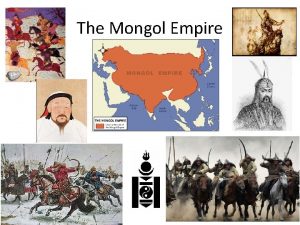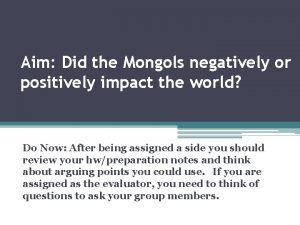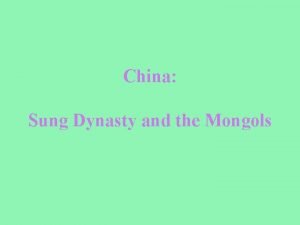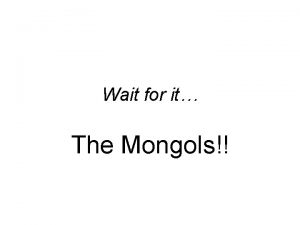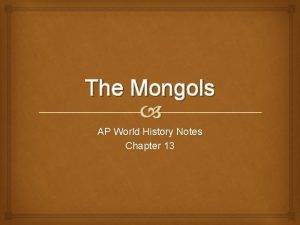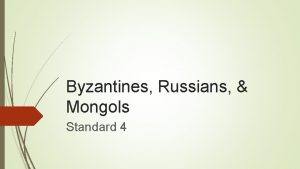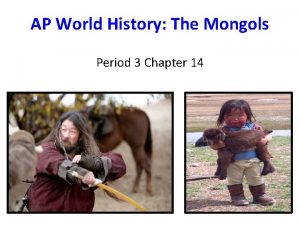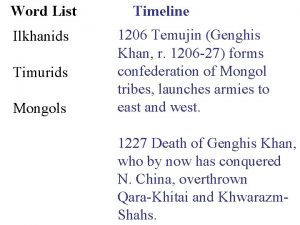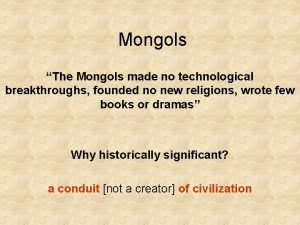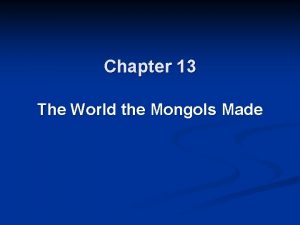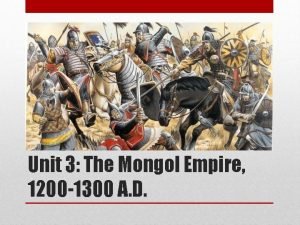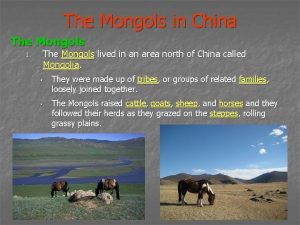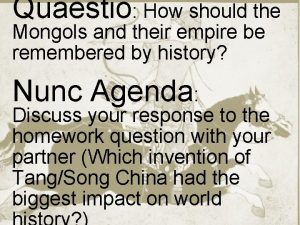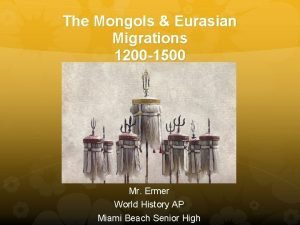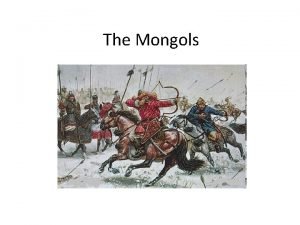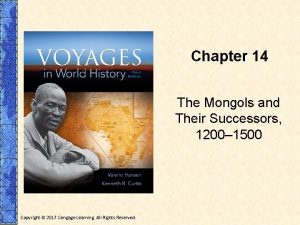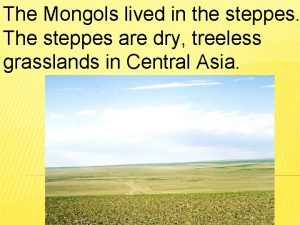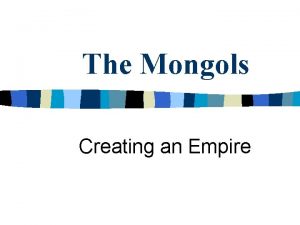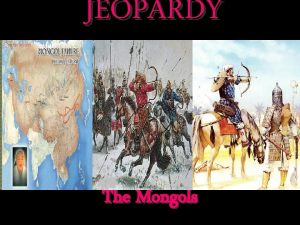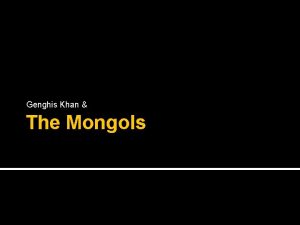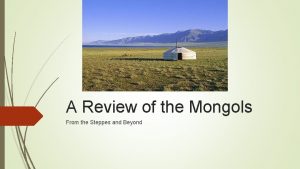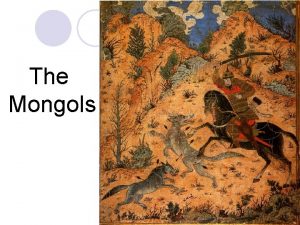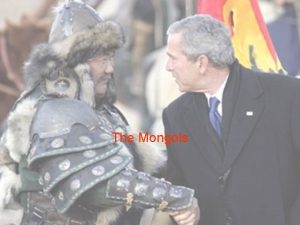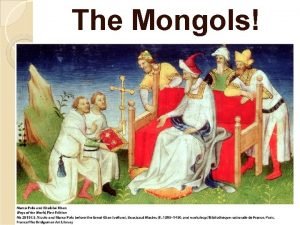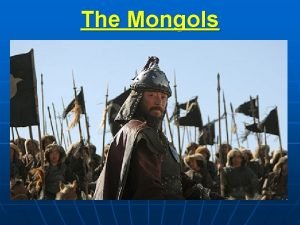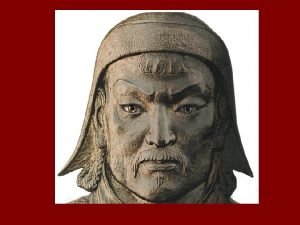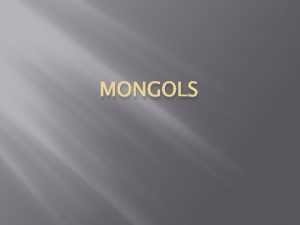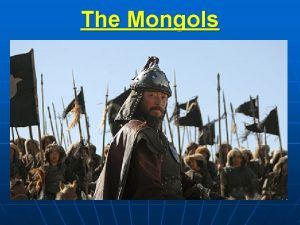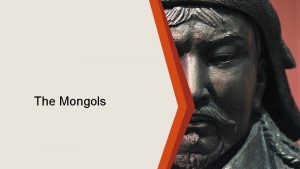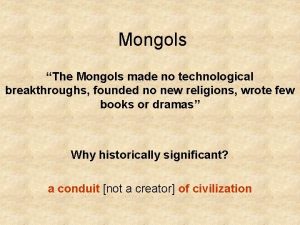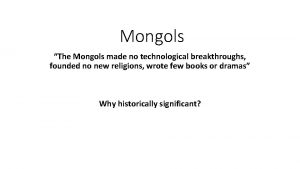The Mongols Asian Steppes Who were the Mongols




















- Slides: 20

The Mongols

Asian Steppes

Who were the Mongols? • Displayed deep loyalty to kin groups organized into families, clans, and tribes. • Strict loyalty to kinship groups made it difficult to organize a stable society on a large scale. • Eventually, Genghis Khan forged the tribes into the largest contiguous empire the world has ever seen.

The name is Khan… Genghis Khan.

GENGHIS KHAN • TEMUJIN was a member of a noble clan • His father forged a small alliance, but was poisoned when Temujin was 10 years old. • Against all odds, he eventually mastered “steppe diplomacy” which called for courage in battle, intense loyalty (but only when convenient), and charisma to entice cooperation

GENGHIS KHAN • By 1206, he united all Mongol tribes under his leadership • They proclaimed him as “Genghis Khan” which meant (universal ruler). • He was a ruthless warrior who demanded strict discipline and loyalty • Often devastated entire cities to encourage others to surrender

A. k. a. … kill people, take their stuff, see and enjoy their pain, and rape their wives for fun “The greatest joy a man can know is to conquer his enemies and drive them before him. To ride their horses and take away their possessions. To see the faces of those who were dear to them bedewed with tears, and to clasp their wives and daughters in his arms. ”

Mongol Organization • Broke up the tribes and forced fighting aged men to join units with no tribal affiliations. • G. K. chose his officers because of their talents or loyalty to him. • G. K. never established a proper capital city, but his successors built one at Karakorum.

Mongol Army • Relied on outstanding equestrian skills • Among the most mobile forces of the premodern world, able to move over 60 miles per day to surprise their enemies. • If enemies surrendered without a fight, they were usually treated leniently. Otherwise they slaughtered whole populations (except usually for artisans)


Conquests • In the early 13 th century – the Mongols conquered northern China and established a regional capital at Khanbaliq (Beijing) • In Central Asia – G. K. sought to open trade and diplomacy with the Khwarazm shah – who stupidly murdered the Mongol envoys… G. K. practically slaughtered the ENTIRE population of the kingdom

Positive Qualities • Superb information gatherers • Steadfast adherence to noble values (courage, endurance, discipline, obedience) • Women enjoyed high status • Strict sense of honor and loyalty, which they recognized and appreciated in their opponents as well. • Promoted religious tolerance wherever they went

GENGHIS KHAN’S LEGACY • Genghis Khan was a conqueror, not an administrator • He ruled the Mongols themselves through the army, but never established a central government • After his death in 1227 CE – the Empire was broken into four major kingdoms

Khanates after his death

Khanates after 1227 • Mongolia & China (Empire of Great Khan) • Central Asia (Chaghadai Khanate) • Persia (Ilkhanate) • Russia (Golden Horde)

In 1241 they began an attack on Hungary and demonstrated a skill that would have conquered all of Europe in less than a year (most likely) but on the eve of the battle, word came from Mongolia that the Khan had died, thus requiring all the descendants to return to elect a new Khan… They never returned.

Pax Tartarica • Time of peace and prosperity for Eurasia from (mid 1200’s to mid 1300 s) • Envoys from the Pope returned with fabulous reports of the Mongols’ power and realms • Marco Polo intrigued Europeans with his stories about Mongol China

Kublai Khan • Established the YUAN dynasty in China • Lover of civilization unlike most Mongols • Personally adopted many Chinese characteristics although the Mongols as a whole alienated themselves from the Chinese people and customs • Encouraged foreign trade • Marco Polo -“the greatest civilization on earth. ”

Kublai Khan • Beyond China, Kublai Khan was not very successful. • He sent expeditions into SE Asia and a naval armada to Java – however Mongol forces didn’t adapt well to the humid, tropical jungles • Attacked Japan, but lost two major fleets due to storms – Japan attributed this fortune to the kamikaze (divine winds)

I am Kublai Khan… Ruler of the Yuan… You make me yawn… So I will smack you at dawn…
 Genghis real name
Genghis real name How did the mongols positively impact the world
How did the mongols positively impact the world Sung dynasty art
Sung dynasty art Wait for it the mongols
Wait for it the mongols Ap world history chapter 13 notes
Ap world history chapter 13 notes Byzantines vs mongols
Byzantines vs mongols Vikings and turks
Vikings and turks The mongols in world history
The mongols in world history Timurid tile
Timurid tile The mongols made no technological breakthroughs
The mongols made no technological breakthroughs The mongols in world history webquest
The mongols in world history webquest Mongols chapter 13
Mongols chapter 13 The mongols in world history
The mongols in world history What did the mongols do for the silk road
What did the mongols do for the silk road Where did kublai khan build palaces
Where did kublai khan build palaces Encountering the mongols comparing three cases
Encountering the mongols comparing three cases How should the mongols be remembered
How should the mongols be remembered Chinese fire lances
Chinese fire lances Mongols miami
Mongols miami Kulbai khan
Kulbai khan Cengage
Cengage
